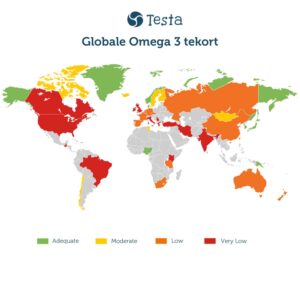The Nordic Secret: Why Scandinavians Turn to Omega-3s During the Dark Season

Living in the Land of Perpetual Winter
Picture this: for nearly four months of the year, the sun barely rises above the horizon. In some parts of northern Scandinavia, complete darkness can last for up to two months. This is the reality for millions of people living in Norway, Sweden, Finland, and Iceland—countries positioned between 54-71°N latitude.
At Nordic and Baltic latitudes, solar radiation just isn’t strong enough to support adequate vitamin D3 synthesis in the skin. During the winter months, the skin virtually stops producing it altogether, making supplementation crucial.
Yet remarkably, Scandinavians have thrived in these conditions for centuries—far before supplementation was popularized. How? The answer lies in their intuitive understanding of omega-3 fatty acids, long before modern science explained why.
The Traditional Nordic Survival Strategy
The traditional Nordic diet isn’t just about surviving, but thriving in extreme conditions. The main ingredients are oily fish such as salmon, herring and mackerel, with the Scandinavian diet containing large quantities of fish that are considered a good source of omega-3 fatty acids.
This wasn’t coincidence. Over generations, Nordic populations discovered that certain foods made them feel better during the long, dark months. They didn’t know about DHA and EPA, but they knew that fatty fish, fermented cod liver oil, and other omega-3 rich foods were essential for maintaining energy, mood, and overall health when the sunlight disappeared.
The Modern Science Behind Ancient Wisdom
Today, research reveals why this traditional approach was so brilliant:
Combating Seasonal Mood Changes
Individuals with depressive disorders display omega-3 deficiencies in biological markers, while omega-3 supplementation has been correlated with improved mood. Low omega-3 levels may predispose certain individuals to depression and anxiety, and dietary supplementation specifically with long-chain omega-3 polyunsaturated fatty acids has represented an interesting strategy for preventing depression and anxiety.
Nordic populations had caught on to this early—not through studies, but in how they felt and performed with the help of these foods.
Supporting Brain Function in Low Light
Omega-3 polyunsaturated fatty acids can play important roles in maintaining mental health and resistance to stress, and omega-3 PUFAs supplementation has, across a range of studies, displayed beneficial effects on both the prevention and treatment of several mood disorders.
When your brain is deprived of sunlight-induced serotonin and vitamin D synthesis, omega-3s become even more crucial for maintaining cognitive function and emotional balance.
The Vitamin D Connection
Here’s where it gets fascinating: During winter in Sweden, when the height of the sun is too low to induce vitamin D production in the skin, serum levels of vitamin D depend on dietary intake and storage alone.
Scandinavians discovered that fatty fish and fish oil provided not just omega-3s, but also natural vitamin D, creating a perfect nutritional duo for dark season survival.
The Modern Nordic Approach
Today’s Scandinavians continue this tradition with both traditional foods and modern supplementation:
Dietary Foundation
The Nordic diet focuses on fatty fish and canola oil rich in omega-3, with fatty fish being the richest dietary source of omega-3s—typically two to three servings a week.
For Nordic peoples, fatty fish like salmon, herring, and mackerel deliver those precious omega-3s, while root vegetables, cabbage, and dark greens provide fiber and nutrients that thrive in cold climates.
Strategic Supplementation
Modern Scandinavians combine traditional fish consumption with targeted omega-3 supplementation, especially during the darkest months when even their fish-rich diet might not provide optimal levels for mood and brain health.
Why This Matters for the Rest of Us
You don’t have to live above the Arctic Circle to benefit from Nordic wisdom. Modern life often creates similar conditions to those they face:
• Urban environments with limited sunlight exposure
• Indoor lifestyles that mimic Scandinavian winters
• Seasonal mood changes that occur even in temperate climates
• High-stress periods when you could benefit from extra omega-3s
The Plant-Based Evolution of Nordic Wisdom

While Scandinavians traditionally relied on fish-based omega-3s, today’s understanding of bioavailability and purity points toward an evolution of this ancient wisdom.
Just as Nordic populations adapted their nutrition to their environment, we can adapt their core insight—targeted omega-3 supplementation during challenging periods—using cleaner, more sustainable sources.
After all, while centuries ago, fish was pure and beneficial, today our oceans’ fatty fish are plagued with industrial-era contaminants, including growing levels of mercury, dioxins, microplastics, and PCBs.
Land-grown algae omega-3s like Testa provide the same essential fatty acids that helped Scandinavians thrive through polar nights, but without the environmental concerns and potential ocean toxins.
The Seasonal Strategy: Timing Your Omega-3 Intake
Scandinavians intuitively understood what research now confirms: omega-3 needs fluctuate with seasons and stress levels. They increased their fish consumption and cod liver oil intake specifically during the darkest months, when their bodies needed extra support for:
• Mood regulation during low-light periods
• Brain function when vitamin D synthesis stops
• Immune support during harsh weather
• Energy maintenance when daylight disappears
Learning from the Masters of Dark Season Survival
The Scandinavian approach to omega-3 during low daylight seasons offers a masterclass in nutritional adaptation. For over a thousand years, these populations have thrived in conditions that would challenge most human societies.
Their secret? Understanding that when environmental conditions become extreme, targeted nutritional support becomes essential. Omega-3 fatty acids were their biological armor against the psychological and physiological challenges of living in near-permanent darkness.
Today, whether you’re facing a Nordic winter, urban light pollution, seasonal mood changes, or just the stress of modern life, the Scandinavian approach offers time-tested wisdom: when conditions get tough, omega-3s help you not just survive, but thrive.
Ready to embrace Nordic wisdom for your own challenging seasons? Discover for yourself how pure, plant-based omega-3 can provide the same protective benefits that helped Scandinavians master life in the dark.



